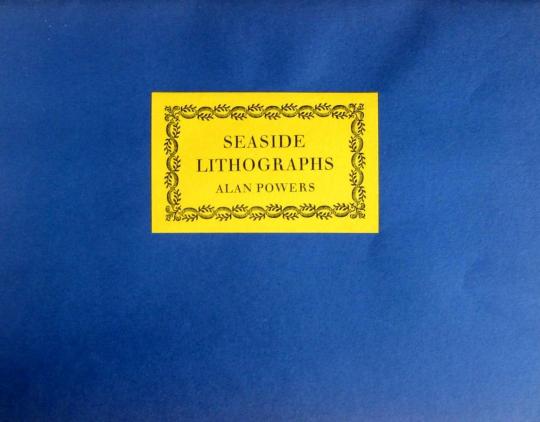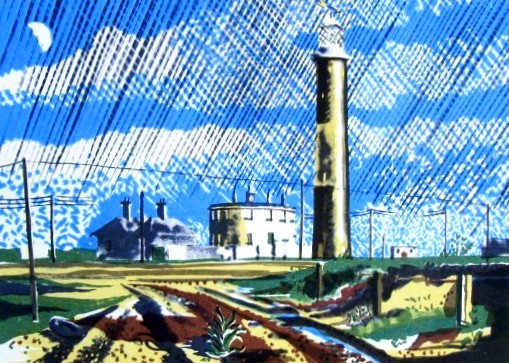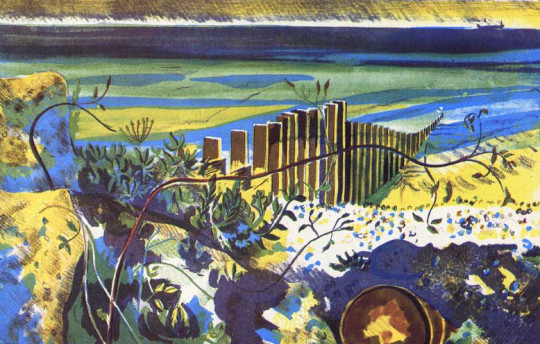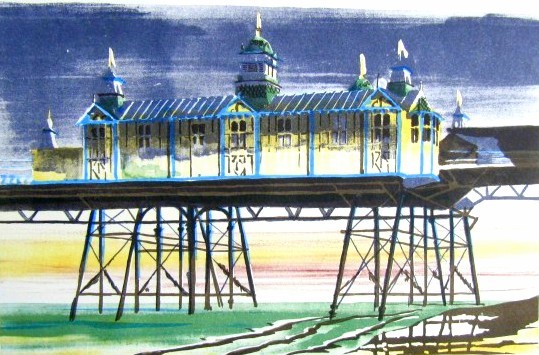
This post is based upon a series of articles in the Spectator during 1986 by author and artist Alan Powers. I thought it interesting and the pictures wonderful to merit a reposting some 31 years later. The lithographs were printed at the Curwen Press.
The series has been commissioned by the Spectator and will be available for sale as a signed, limited edition.
Dungeness

Alan Powers – Dungeness
From Hythe the coast road loses sight of the sea behind the sea walls protecting Romney Marsh. Bungalows and caravans punctuate the progress through Dymchurch and New Romney. From Littlestone to Dungeness is all Shingle, with plenty of fishing boats and tarred huts on the seaward side. The Buildings of England condemns ‘the scruffy shacks that sprawl for miles’, but Dungeness, innocent of architect or planner, has a quality of its own.
It is one of the best Places left for seeing railway carriages Converted into dwellings in the Twenties and Thirties, a rare memorial of the world of Rowland Emmett. He too is the presiding genius of the Romney, Hythe and Dymchurch railway, with miniature steam engines each about the side of an old Bugatti puffing along the shingle to nowhere and back. Lupins and yellow sea poppies grow beside the track. Dungeness Lighthouse, built in 1904, was a favourite subject for painters in the Thirties like John Piper and Eric Ravilious.
Then it was a lone landmark with a prominent midriff of white. The strange circular house on the left is the remains of Samuel Wyatt’s original lighthouse of 1792. Both have been superseded by a concrete lighthouse of 1959 which broadens toward the top for a change. They all share in the salty functionalism which Piper called the Nautical Style. Now the non-nostalgic painter ought really to look just out of the picture to the right, where the twin nuclear power stations are as incongruously gigantic as the railway is miniature. They contribute to the quasi-surrealist genius of Dungeness, and from Winchelsea or Fairlight they wink whitely against distant storm clouds.
The Ness used to be growing rapidly with accretions of shingle. It shelves steeply into the sea, leaving a deep channel for shipping near the coast. The Ministry of Defence has bagged most of the shore from Lydd to Camber, where the sand returns abundantly across the boundary into Sussex.
Brighton — Nocturne

Alan Powers – Nocturne
Aquarium Amusements keeps it up till the late hours. By night, the cries of a mechanical parrot carry across the upper air demanding, like an electronic club-bore, ‘Come and talk to me’. Nobody does, for the roundabout of giant ladybirds is stilled and children are pushed home by weary parents, clutching the last ice-cream. The name of the Palace Pier suddenly lights up, like the end of a firework display. From the ballroom the distant music sets the somnolent house-fronts swaying with stucco syncopation. Nobody rides till tomorrow on the pug-dog fireman whose head surfaces above the concrete balustrade. Like Mr Belaker, ‘the allegro, negro, cocktail shaker’, he will wait until the neo-Renaissance lamps are dimmed before he cruises the promenade from Kemp Town to Hove in search of a ghostly lover.
The Aquarium was reconstructed in 1929 and opened by H.R.H. Prince George. The Official Corporation Handbook (1936 edition) notes how `fish of all sorts lead care-free lives in commodious tanks and a kind of Celtic twilight’. There was also ‘a very comprehensive Amusement Arcade, including a Scoota Boat Pool, Dodgem Cars, Ghost Train, Mirror Maze and the latest devices for the amusement of children, such as Jungle Ride, Aerial Ride, etc’. The Spirit of Brighton, so memorably awakened by the Prince Regent in Rex Whistler’s mural, has spread around the middle and needs fairly constant make-up, but she has never yet gone back to her seaweedy bed. Her moralising sister Hove may pull down the blinds, but Brighton carries on anyhow. Like the Pavilion, Brighton turns its back on the sea and the unattractive beach. Yet the sea air brings an architectural intoxication, encouraging strange growths. And would those domes and minarets have sprouted quite the same in Horsham or in Hayward’s Heath?
Climping Beach

Alan Powers – Climping Beach
Climping Beach comes at the end of a country road, where flint-walled thatched barns are the only buildings. A tower block in Littlehampton is distantly apparent, but here there is a rural respite. ‘The only unbuilt piece of coastline between Selsey and Brighton’ (Buildings of England).
The wartime defences, mainly cubes of concrete, are crumbling away slowly and convolvulus twines where barbed wire was before. Soon nothing will be left to show where we nearly fought on the beaches and the landing grounds. The shifting coastline is held in place by majestic groynes, a fitting man-made addition to the elements of sea and shingle.
In the woods behind is a more complicated defence against the tides of time. Bailiffscourt does actually occupy a mediaeval site and has a genuine 13th-century chapel. The rest is a highly convincing spoof-mediaeval house of the 1930s. It was built for Lord Moyne by an antique-dealer, Amyas Phillips, and intended as an instant antiquity from Chaucer’s England, including many fragments from old buildings which were being demolished at the time. The pastiche is brilliant, and still good as a Thirties-style house. The complete story is told in Clive Aslet’s The Last Country Houses. Lady Moyne scattered wild flower seed from the windows of the London train. All the trees at Bailiffscourt were imported fully grown and held upright in the sandy soil with steel hawsers and guy-ropes. It was a frantic search for innocence, yet the Moynes saved Climping from being ‘developed’.
Felpham, the next village along, was not so lucky. It is now part of Bognor, but is remembered as the place where William Blake stayed in 1800-1801 as the guest of William Hayley. The great visionary had never seen the sea be- fore, but he seems to have been more impressed with his cottage. He wrote to Thomas Butts: ‘My Wife and Sister are both very well and are courting Neptune for an Embrace, whose terrors this morning made them afraid, but whose mildness is often Equal to his terrors.’

Alan Powers – Eastbourne